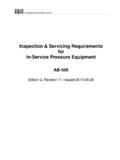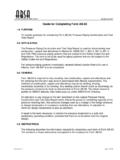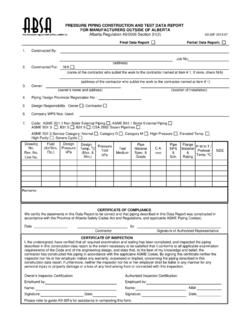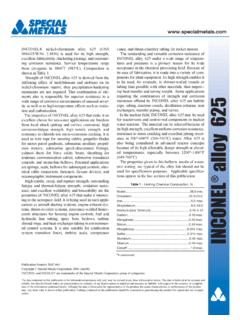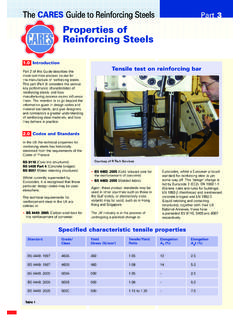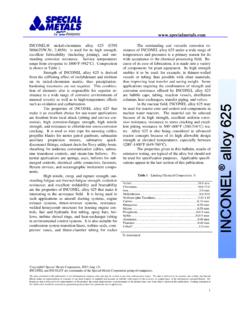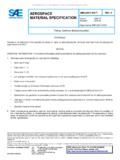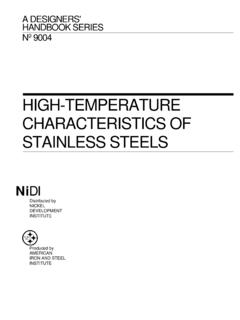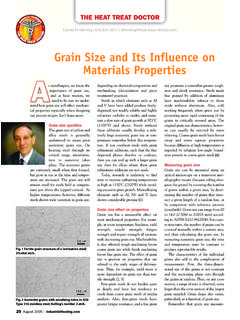Transcription of Use of Mandatory Appendix 44 of ASME 2013 …
1 Information Bulletin No. IB13-016 December 31, 2013. Use of Mandatory Appendix 44. of asme 2013 Section VIII, Division 1 in Alberta Background Mandatory Appendix 44 provides the requirements for design and construction of cold-stretched austenitic stainless steel pressure vessels under the rules of asme Boiler and Pressure Vessel Code, Section VIII, Division 1 2013 edition. This Mandatory Appendix 44 is, with minimal editorial modifications, identical with previously issued asme Code Case 2596. For vessels designed and constructed to the earlier editions of the adopted asme Code (prior to 2013-07-01) and with the use of asme Code Case 2596, compliance with IB13-008 is Mandatory . Although the effects of cold work hardening on metal properties have been known for a long time, the use of cold-stretching of pressure vessels to enhance material properties is a relatively new technology. Austenitic stainless steel work hardens and thereby increases the yield strength when deformed plastically at room temperature.
2 The increased yield strength results in the use of higher allowable design stress per provisions of Mandatory Appendix 44 rules in which design stresses are controlled by a design factor to yield strength only. Mandatory Appendix 44 rules do not apply a design factor of to the minimum specified tensile strength of the material to establish the allowable design stress values published in Table in the Mandatory Appendix , even though the design factor of is normally used in Section VIII, Division 1 to establish allowable stress values for materials where maximum design temperatures do not exceed 120oF (50oC). Provisions This document defines the requirements that must be met for the use of Mandatory Appendix 44. in the design and construction of cold-stretched pressure vessels for use in the Province of Alberta. This document also establishes conditions that must be met for the installation, operation, repair and alteration of cold-stretched pressure vessels in Alberta.
3 1. General Requirements All provisions of Mandatory Appendix 44 must be adhered to. Use of Mandatory Appendix 44 with asme Code Case 2695 (Code Case 2695 allows the use of the asme Section VIII, Division 2 design rules for the construction of a pressure vessel to asme Section VIII, Division 1) is prohibited. Page 1 of 8. Information Bulletin IB13-016 Page 2 of 8. Use of Mandatory Appendix 44. Use of any other asme Code Cases or Code Interpretations in conjunction with Mandatory Appendix 44, must be clearly specified in the design registration submission. Mandatory Appendix 44 may only be used for design and construction of cryogenic storage tanks in non-corrosive/erosive service where stored fluid(s) would not have any adverse effect on the pressure vessel austenitic stainless steel. In addition to the requirements in Mandatory Appendix (e), the following conditions shall be met: If multiple shell cylinders are used, all shell cylinder plates shall be of same uniform nominal thickness.
4 Dished heads are the only head shape allowed. Heads shall satisfy the following conditions: Head minimum thickness after forming must be at least equal to the minimum calculated design thickness plus the thinning allowance for cold-stretching; and The ratio of the head actual (measured) minimum thickness to the head design minimum thickness must not exceed Mandatory Appendix 44 is not permitted to be used for vessels which are subject to loadings as defined in: UG-22(e),(g),(h) and (i). special service defined in UW-2 ( lethal service). The Manufacturer must develop and verify (qualify) the cold-stretching procedure (CSP) before starting to build any pressure vessels using cold-stretching technology. In addition to all requirements specified in Mandatory Appendix 44, the CSP shall include the necessary details to produce the required results. The CSP must address, but it is not limited to, the following: scope and details of the CSP including cold-stretching operation.
5 Procedure limitations (including material and dimensional limitations);. allowed variation (tolerances) in actual plate thickness (shell and heads);. an explanation as to how the strain is measured and controlled;. locations for measuring critical dimension changes during cold-stretching;. frequency of measuring and frequency of the strain rate calculations;. a repair procedure including the acceptance criteria for the repair, if repairs are to be allowed;. detailed methodology for repeating cold-stretching after repair completion by welding as a result of non-conformance during the manufacturing process; and verification/qualification of the CSP including: Proof that materials, after cold-stretching is performed in accordance with the procedure requirements, are achieving or exceeding the allowable design stresses specified in Table 44-4-1 of Mandatory Appendix 44;. Test coupons shall be cold-stretched in a way to be true representatives of the cold-stretched vessel components.
6 Tensile tests shall be performed and results reported;. The procedure qualification shall be witnessed by the Authorized Inspector; and Information Bulletin IB13-016 Page 3 of 8. Use of Mandatory Appendix 44. The procedure qualification report signed off by the Manufacturer and an Authorized Inspector. The CSP shall be a controlled document with tracking of all revisions. The CSP. document number and revision shall be specified both in the design submission drawings for registration and in the Manufacturer s Data Report. 2. Design and Design Submission Requirements A User Design Specification (UDS) notes #1 and 2 shall be prepared and be included in the design registration submission. It is the Owner s (User) responsibility to define the format and content of the UDS, which will be subject to review and acceptance as part of the design registration process. Among other details, the UDS shall: clearly define all requirements for cold-stretching.
7 Include a statement to confirm the acceptance of the manufacturer s cold- stretching procedure;. specify how the requirements of this document (IB13-016) will be met; and specify the number of cold-stretched pressure vessels that are to be built under the UDS. The UDS shall be reviewed and certified by a Professional Engineer experienced in the design and construction of pressure vessels which utilize cold-stretching technology and who meets the requirement of Section 1(2) of the Pressure Equipment Safety Regulation (AR49/2006) . Each design submission application shall include a letter from the owner (user) stating acceptance that: Mandatory Appendix 44 will be used for this pressure vessel design; and Any possible future repair and/or alteration can not be performed utilizing welding, without performing additional cold-stretching of the vessel. The Manufacturer must submit a Manufacturer Design Report note #3 that will include details of the pressure vessel design and the serial numbers of the cold-stretched pressure vessels.
8 The Manufacturer Design Report shall be reviewed and certified by a Professional Engineer experienced in the design and construction of pressure vessels which utilize cold-stretching technology and who meets the requirement of Section 1(2) of the Pressure Equipment Safety Regulation (AR 49/2006). In addition to the requirements specified in sections 14 and 15 of the Pressure Equipment Safety Regulation (AR 49/2006), the drawings submitted for design registration must also include: The cold-stretching pressure (Pc);. Reference to the CSP including the document number and revision number;. Design, fabrication, inspection, stamping requirements of Mandatory Appendix 44 and this document;. All non-destructive examination requirements;. Hydrostatic test pressure value per UG-99(b);. Information that full volumetric examination (RT or UT) will be performed on all butt joints before cold-stretching of the vessel in accordance with Mandatory Appendix 44, paragraphs 44-5(e) and (c), asme Section VIII Division 1, paragraphs UW-11(a) and UW-51, and Information Bulletin IB13-016 Page 4 of 8.
9 Use of Mandatory Appendix 44. the acceptance criteria for size of indications as specified in Section of this document;. A report of any physical tests conducted for the purpose of establishing the MAWP of the pressure vessel or any part thereof; and Other information that is necessary to support the design. The CSP must be included as a part of the design registration application submission. Utilization of cold-stretching is not permitted for parts with primary bending stresses. Excessive rigidity and restriction of expansion shall be avoided note #4 in the design of cold-stretched pressure vessels. Circumferential reinforcement shall not be used. In compliance with Mandatory Appendix (g) impact test requirements, the design submission (drawings) shall indicate the impact test temperature and energy value. For nozzle reinforcement calculations, the rules and provisions of UG-37 are permitted but use of alternative rules under Appendices 1-9 and 1-10, and Code Case 2695 are prohibited.
10 For large openings exceeding the limits specified in UG-36(b)(1), a design submission must address how supplemental rules of 1-7 will be satisfied in addition to the rules of UG-37. In addition to the requirements Mandatory Appendix 44, paragraph (g) and requirements of paragraph UG-37 of asme Section VIII, Div. 1, reinforcement calculations of openings shall comply with the following conditions: Spacing between nozzles must be such that limits of reinforcement calculated according to UG-40 do not overlap; and Provisions of paragraph UG-37 are modified as follows: Area of reinforcement required (A) is calculated A=d tr where tr = t;. Area of excess thickness in the vessel wall available (A1) is taken as zero;. Required thickness of a nozzle wall (trn) is calculated using the rules of asme Section VIII, Div. 1 and applying allowable stress value specified in asme Section II, Part D;. Area of excess thickness in the nozzle wall (A2) is calculated using value for trn calculated in accordance with the rules in this section.
